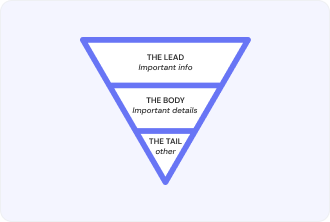Inverted Pyramid Definition

Inverted Pyramid is a term in psychology that refers to the structure of an article demonstrating how it should be structured and represented. The core principle of such method is that the leading information should be placed at the top of an article, and then according to the level of decrease less vital information should be placed above. In terms of UX design it can be implemented to the content you place at web pages.
As for benefits of such method you can make users understand what the topic is about from the first sentence and structure your content so it will be engaging and useful for your target audience. Moreover you should frontload all the required and essential information at the top of the article which is perfect method for short descprions and long reads as well.
How does Inverted Pyramid look?
To put it simply there are three parts that flow down from the vital part to the optional one. Here how it looks based on an example of a mobile app creation:

Therefore, at the beginning of the project it is all about defining why business needs it, what is the main goal, and so on.
Then, you decide on features that have to be built, from pop-ups to log in and niche-tailored functionality.
At the end, you focus on supporting details like technologies you need, databases, frameworks, and more tech nuances.
Undoubtedly you will adapt it to the idea you are working on, and modify it according to the phases of your development process.
Where is Inverted Pyramid also used?

Such a writing structure is about priorities which is fitable for many niches from personal to businesses, and we will consider how it is implemented across various fields and the IT area at the first place.
-
Information technology typically incorporate Inverted Pyramid in aspects as documentation, communication and UI/UX design plus web content creation that follows these factors.
When working with API docs, you can use Inverted Pyramid to set the priorities for tools, libraries, and other components. When it comes to user experience, you define what comes first in their pain points, main objective, and other points.
If you are a developer, you know that such a technique is used for features you build, as you go from the must-have ones to nice-to-have.
-
Journalism is known for the technique of 5 Whys: who, what, where, why and when thatg is also implemented across Inverted Pyramid as the war for readers attention requires making content usable and flawless, and defining what stands first is essential.
-
Communication in business is about setting priorities to save time and money resources as you can not miss core elements while talking about all the available ones. Here you receive a better problem-solving skills as you definitely know what to discuss first.
To tell more it is also used in architecture as the Hanoi Museum is built in such a shape with a deep meaning. It is an art in IT and other industries, mastering which you receive an advantage of being a leader as you know your priorities.